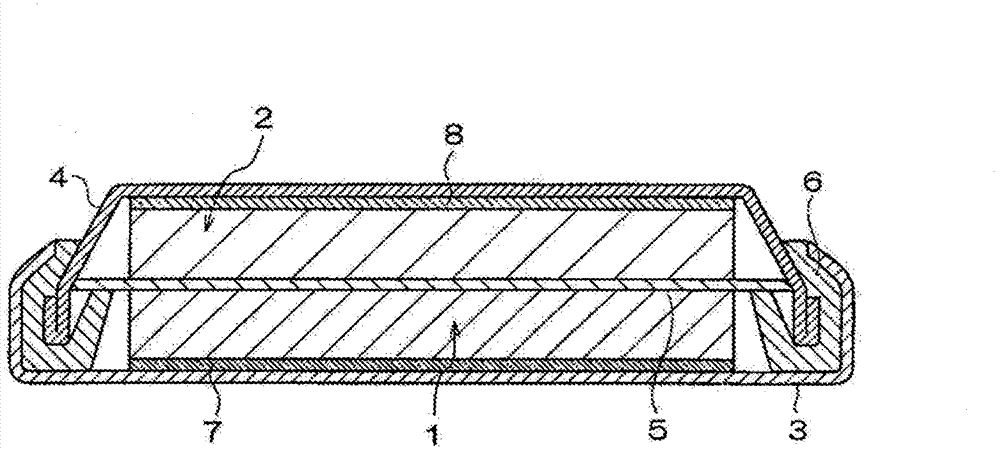Cyclic sulfate compound, non-aqueous electrolyte solution containing same, and lithium secondary battery
A non-aqueous electrolyte and cyclic sulfate technology, which is applied in the field of cyclic sulfate compounds, non-aqueous electrolytes containing it, and lithium secondary batteries, which can solve the problem of reduced battery energy density, increased resistance, and reduced battery performance And other issues
- Summary
- Abstract
- Description
- Claims
- Application Information
AI Technical Summary
Problems solved by technology
Method used
Image
Examples
Embodiment
[0259] Hereafter, although an Example demonstrates this invention more concretely, this invention is not limited to these Examples. In addition, in the following examples, "%" means mass %.
[0260] Hereinafter, a synthesis example of the cyclic sulfate ester compound represented by the general formula (I) will be given.
Synthetic example 1
[0262]
[0263] (Process 1)
[0264] According to the method described in Tetrahedron: Asymmetry, 1999, vol.10, (24), p.4755-4762, 4-hydroxymethyl-2-oxo was obtained from glycerol (36.8g) and thionyl chloride (47.6g) - 47.0 g of 1,3,2-dioxathiolane (85% yield).
[0265] (Process 2)
[0266] The above 4-hydroxymethyl-2-oxo-1,3,2-dioxathiolane (6.91g, 50.0mol) was dissolved in tetrahydrofuran (140ml), and triethylamine (13.9 ml, 100mmol) and methanesulfonyl chloride (4.3ml, 55mmol), stirred for 3 hours. Water was poured into the reaction solution, followed by extraction with ethyl acetate. The extract was washed with dilute aqueous hydrochloric acid and saturated brine, dried over anhydrous magnesium sulfate, and concentrated. The residue was purified by silica gel chromatography (elution solvent: hexane / ethyl acetate = 2 / 3) to obtain 4-methylsulfonyloxymethyl-2-oxo-1,3,2-dioxathiolane Alkane (9.47g, 88% yield).
[0267] The NMR measurement results of the above compounds...
Synthetic example 2
[0274]
[0275] In Step 2 in the synthesis of Exemplary Compound 1, the same operation as that of Exemplary Compound 1 was carried out except that methanesulfonyl chloride was replaced by ethanesulfonyl chloride to obtain Exemplary Compound 2 (3.37 g, yield 63%).
[0276] The NMR measurement results of Exemplary Compound 2 are as follows.
[0277] 1 H-NMR (270MHz, CDCl 3 )δ (ppm): 5.23-5.16 (1H, m), 4.83 (1H, dd, J = 9.2, 6.6), 4.65 (1H, J = 9.2, 5.9), 4.52 (1H, dd, J = 12.5, 4.0 ), 4.47 (1H, dd, J=12.5, 4.0), 3.26 (2H, q, J=7.6), 1.48 (3H, t, J=7.6)
PUM
| Property | Measurement | Unit |
|---|---|---|
| interplanar spacing | aaaaa | aaaaa |
| actual density | aaaaa | aaaaa |
| packed density | aaaaa | aaaaa |
Abstract
Description
Claims
Application Information
 Login to View More
Login to View More - R&D
- Intellectual Property
- Life Sciences
- Materials
- Tech Scout
- Unparalleled Data Quality
- Higher Quality Content
- 60% Fewer Hallucinations
Browse by: Latest US Patents, China's latest patents, Technical Efficacy Thesaurus, Application Domain, Technology Topic, Popular Technical Reports.
© 2025 PatSnap. All rights reserved.Legal|Privacy policy|Modern Slavery Act Transparency Statement|Sitemap|About US| Contact US: help@patsnap.com



